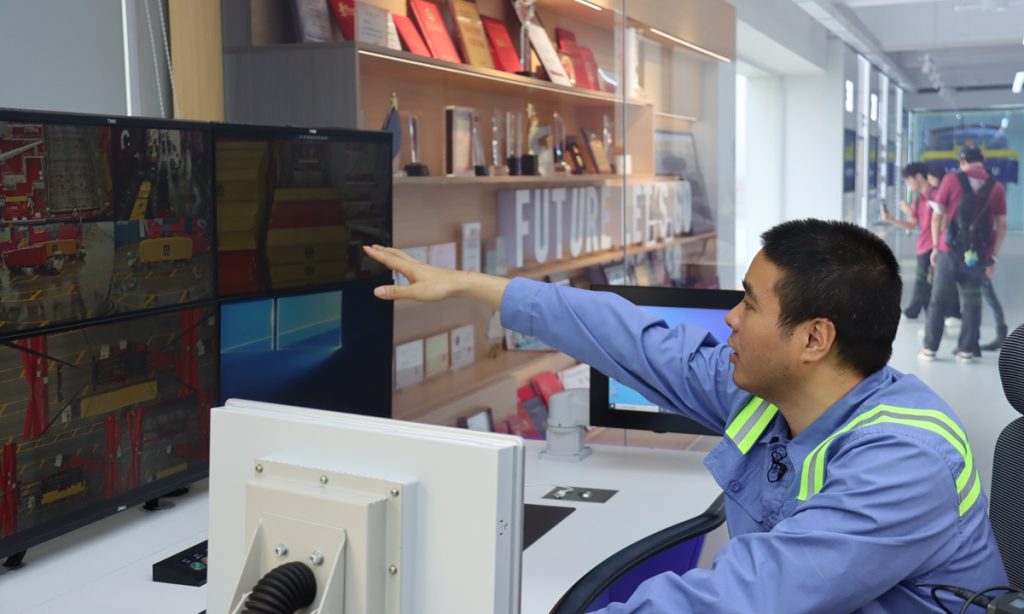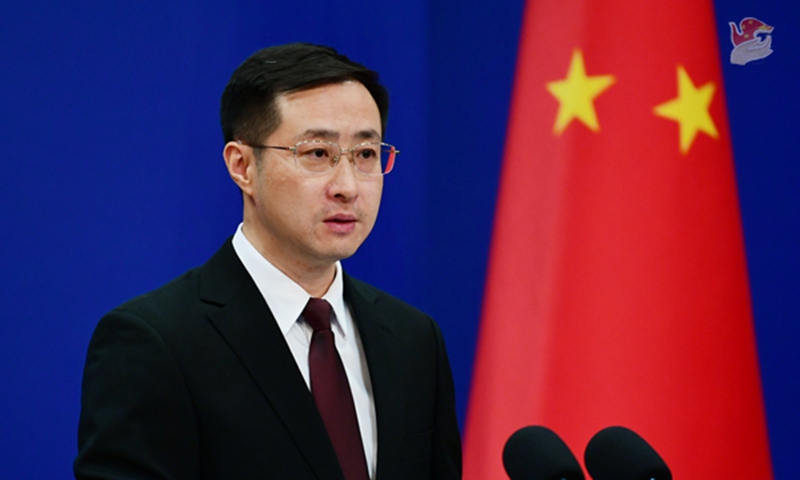Threading the needle in the sky

As a national model craftsman and technical expert, Zhu Shijie has significantly contributed to Ningbo-Zhoushan Port's success. His self-developed crane operation method and leadership in innovation have propelled the port to new heights, setting a world record of lifting 185 containers per hour.
Currently, the port's cargo throughput of 1.26 billion tons and container throughput of 33.35 million TEUs make it ranking first and third globally. This stems from the indispensable contribution of Zhu and his team.
During President Xi Jinping's visit to the port in March 2020, Zhu demonstrated his unique bridge crane operation method to the president, who later encouraged him to continue fostering exemplary talent and leveraging the role of a model worker.
Recently, the Global Times interviewed Zhu, getting a closer insight into the craftsman's creative spirit and his team's relentless pursuit of excellence. Their dedication to innovation and efficiency has played a pivotal role in transforming the country's ports into the world's leading green and intelligent ports, showcasing new productive forces and global leadership.
From challenging youth to crane operation expert
For Zhu Shijie, a crane operator at Ningbo-Zhoushan Port, his personal aspirations are deeply intertwined with the port's development.
Born in 1980 to a family in Ningbo, East China's Zhejiang Province, known for its strong technical background, Zhu spent his childhood surrounded by the sound of ship whistles.
From a young age, Zhu had a deep interest in large machinery. His dream was to become a truck driver, navigating the world with large vehicles carrying goods. Driven by his admiration for technical worker, Zhu entered a technical school to study port machinery operation in 1995.
Suffering from severe obstructive sleep apnea, he faced significant challenges in his studies. Sports thus became his stage for self-expression and building confidence. On campus, he was a core member of the track and field team, excelling in shot put, discus, and middle-distance running. Sports not only enhanced his physical capability, but also shaped his steadfast character.
Joining Ningbo Port in December 1998, Zhu started his career in high-altitude crane operations, a task often described as "threading the needle in sky." This involves maneuvering a swinging spreader to align with a container's lock hole, requiring precision within two centimeters amid the challenging conditions of sea winds and waves. Despite battling respiratory issues in his youth, Zhu leveraged his background as an athlete to overcome physical challenges and excel in his demanding role.
"Our highest equipment reaches 49 meters," Zhu told the Global Times. "Operators work in confined spaces, using hand controls to perform precise tasks while maintaining intense focus for hours. This job is demanding, requiring continuous operation 24 hours for a week in rotating shifts."
Working in the challenging environment of crane operations, Zhu was not content with just performing his duties. He constantly sought ways to improve efficiency and safety. However, he and his team met a problem: it seems impossible to achieve both speed and stability in bridge crane operations.
"Speed and stability seemed mutually exclusive," Zhu recalled. "Whenever I pushed the controls too far, the spreader would swing uncontrollably, increasing the risk of accidents."
Zhu realized that to handle bridge cranes from various manufacturers with differing characteristics, he needed a standardized method to achieve precise control. This was no easy task. However, a serendipitous observation of a pendulum on his desk sparked an idea. He noticed the pendulum's motion mirrored the swinging of the crane's spreader.
Inspired by this, Zhu began experimenting with the principles of pendulum movement, aiming to stabilize the crane's spreader. By adjusting the speed and acceleration of the crane's platform, he felt more and more effective in controlling the swinging of the crane's spreader. This finally led to the development of a systematic approach to crane operations, significantly enhancing both efficiency and safety.
Over the years, driven by a deep sense of responsibility and a desire to improve working conditions for his colleague, he continued developing this technique which he later upgraded to "version 3.0."
Championing innovation with a human touch
On June 26, the State Council Information Office held a press conference, using port and shipping operations as a case study to showcase China's transformation toward intelligent waterway upgrades.
Zhu and his team's commitment to innovation is an epitome of the country's constant efforts. The Meishan Port Area of Zhoushan Port, where Zhu works, began its transition from traditional operations to an intelligent port since 2016, by introducing remotely controlled cranes and automated gantry cranes, which could enable operators to avoid working in high altitudes at the risk of their health.
"The remote-control simulation system allows operators to manage crane operations from a comfortable office environment, significantly reducing physical strain while maintaining high efficiency," Zhu explained.
Zhu's innovative approach was driven by his belief in creating a more humane and intelligent working environment. "I always wanted to improve productivity and liberate myself and my fellow workers, allowing us to work in a more comfortable and intelligent environment," Zhu said.
So far, the system's accuracy had reached approximately 95 percent of on-site operations, the Global Times has learned.
Zhu's dedication to innovation and efficiency has had a lasting impact on Ningbo-Zhoushan Port. His pioneering techniques have significantly increased the port's productivity. One notable achievement of Zhu's methods is the ability of a single shift of 40 cranes to handle an additional 1 million containers annually, equivalent to the capacity of an entirely new berth.
His relentless pursuit of excellence in crane operation has also earned him numerous national honors, transforming him from an ordinary crane operator into a pivotal figure influencing industry development.
Maintaining his initial commitment from a decade ago -- to create better working conditions for his fellow workers and liberate productivity, Zhu's journey of exploration and innovation continues.
"We are entering the era of AI. I hope that the insights I've gathered over the years can be translated into AI learning, enabling automation of repetitive tasks. We are always embracing the future with optimism," he said.

